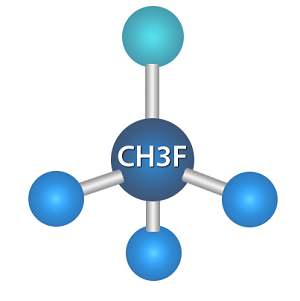What is Methyl Fluoride?
General Description
Fluoromethane, also known as methyl fluoride, Freon 41, Halocarbon-41 and HFC-41, is a non-toxic, liquefiable, and flammable gas at standard temperature and pressure. It is made of carbon, hydrogen, and fluorine. The name stems from the fact that it is methane (CH4) with a fluorine atom substituted for one of the hydrogen atoms. It is used in semiconductor manufacturing processes as an etching gas in plasma etch reactors.

Methyl Fluoride (or fluoromethane) is a colorless flammable gas which is heavier than air. Methyl Fluoride has an agreeable ether-like odor. Methyl Fluoride is narcotic in high concentrations. Methyl Fluoride burns with evolution of hydrogen fluoride. The flame is colorless, similar to alcohol. Under prolonged exposure to fire or intense heat the containers may rupture violently and rocket.
Reactivity
Methyl fluoride (or fluoromethane) is a colorless flammable gas which is heavier than air. It has an agreeable ether-like odor. It is narcotic in high concentrations. It burns with evolution of hydrogen fluoride. The flame is colorless, similar to alcohol. Under prolonged exposure to fire or intense heat the containers may rupture violently and rocket.
Halogenated ali phatic compounds, such as METHYL FLUORIDE, are moderately or very reactive. Reactivity generally decreases with increased degree of substitution of halogen for hydrogen atoms. Low molecular weight haloalkanes are highly flammable and can react with some metals to form dangerous products. Materials in this group are incompatible with strong oxidizing and reducing agents. Also, they are incompatible with many amines, nitrides, azo/diazo compounds, alkali metals, and epoxides. The prolonged mixing of halogenated solvents with metallic or other azides may cause the slow formation of explosive azides, for example methylene chloride and sodium azide, [Chem. Eng. News, 1986, 64(51)].
Health Hazard
Narcotic in high concentrations. Acts as a simple asphyxiant. Burns with evolution of hydrogen fluoride. The flame is about as colorless as that of alcohol. When heated to decomposition it emits toxic fumes of F-.
Vapors may cause dizziness or asphyxiation without warning. Some may be irritating if inhaled at high concentrations. Contact with gas or liquefied gas may cause burns, severe injury and/or frostbite. Fire may produce irritating and/or toxic gases.
Disease relevance of fluoromethane
Vasodilator responses to induced hypercapnia were tested during inhalation of 5% CO2 in 95% 02 while regional cerebral blood flow was measured by fluoromethane inhalation positron emission tomography. We report the vasocapacitance of the cerebral circulation, as determined by cerebral blood flow reactivity to induced hypercapnia using fluoromethane positron. emission tomography, in 32 patients with unilateral anterior circulation transient ischemic attacks. Determination of regional cerebral blood flow in patients with cerebral infarction. Use of fluoromethane labeled with fluorine 18 and positron emission tomography.
Fire Hazard
EXTREMELY FLAMMABLE. Will be easily ignited by heat, sparks or flames. Will form explosive mixtures with air. Vapors from liquefied gas are initially heavier than air and spread along ground. CAUTION: Hydrogen (UN1049), Deuterium (UN1957), Hydrogen, refrigerated liquid (UN1966) and Methane (UN1971) are lighter than air and will rise. Hydrogen and Deuterium fires are difficult to detect since they burn with an invisible flame. Use an alternate method of detection (thermal camera, broom handle, etc.) Vapors may travel to source of ignition and flash back. Cylinders exposed to fire may vent and release flammable gas through pressure relief devices. Containers may explode when heated. Ruptured cylinders may rocket.
);

